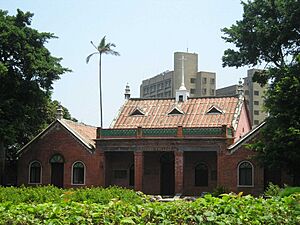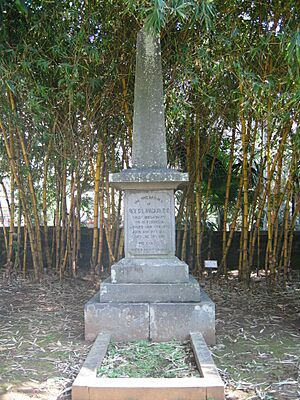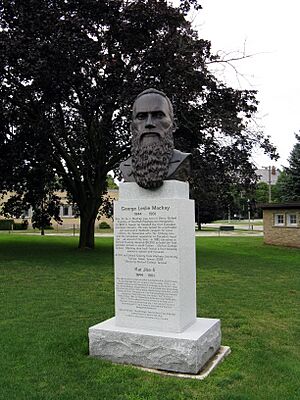George Leslie Mackay facts for kids
George Leslie Mackay (also known as 偕瑞理 or 馬偕 Má-kai; born March 21, 1844 – died June 2, 1901) was a Canadian Presbyterian missionary. He was the first Presbyterian missionary to northern Taiwan (which was then called Formosa). He worked with the Canadian Presbyterian Mission. Mackay is one of the most famous and important Westerners who lived in Taiwan.
Contents
Early Life and Education
George Leslie Mackay was born on March 21, 1844. He was the youngest of six children in a Scottish family that had moved to Embro, Zorra Township, Oxford County, Canada West (now Ontario), Canada. His family were pioneers who had come from Scotland in 1830. They were part of a group called the Zorra Pioneers. Their church was very important to their community life.
Mackay studied to become a minister at different schools. He went to Knox College in Toronto (1865-1867), Princeton Theological Seminary in the United States (1870), and New College, Edinburgh in Scotland. All these schools were Presbyterian. During Mackay's time, Princeton and Edinburgh were important places for learning about and preparing for missions in other countries.
Mission to Taiwan
In 1871, Mackay became the first foreign missionary sent by the Canada Presbyterian Church. He arrived in Taiwan on December 29, 1871.
After talking with Dr. James Laidlaw Maxwell Sr., a doctor who was also a missionary in southern Formosa, Mackay settled in Tamsui, northern Formosa, in 1872. Tamsui remained his home until he died in 1901. He started by helping people with their teeth, especially the lowland Indigenous people. Later, he built churches, schools, and a hospital that used Western medicine.
Mackay quickly learned to speak Taiwanese very well. He married a local Taiwanese woman named "Minnie" Tiu (Chinese: 張聰明; Pe̍h-ōe-jī: Tiuⁿ Chhang-miâ). They had three children together:
- Mary "Tan" Mackay
- Bella "Koa" Mackay
- George William Mackay
Another missionary, Rev. William Campbell, described Mackay as "a little man, firm and active, of few words, unflinching courage, and one whose sound common sense is equalled only by his earnest devotion to the Master." He also said that Mackay started teaching and training young men in Tamsui, which helped many people in northern Taiwan.
Mackay traveled all over northern Taiwan with his students. These students later became pastors of the churches he started. Together, they founded 60 churches. These churches in northern Taiwan later became part of the Northern Synod of the Presbyterian Church in Taiwan.
Mackay's Impact on Society
Helping the Kavalan People
When Mackay preached to the Kavalan people (噶瑪蘭) in the 1880s, something special happened. The Kavalan were facing very hard times. Chinese settlers had taken their land, and their culture was changing. They were also very poor. Mackay's Christian teachings, which spoke of equality and hope, combined with their desire to resist these changes. This led to a strong movement among the Kavalan people.
A historian named John Shepherd wrote about the difficulties the Kavalan faced. Chinese settlers came to their land very quickly in the 1800s. The Kavalan were not ready for such fast changes. They lost their land and became very poor. By the end of the 1800s, the Kavalan population had dropped by about 70 percent. Many moved to other areas.
Another historian, Chan Su-chuan, described the "extremely difficult situation" for the Kavalan in the 1880s. Their traditional way of life and religion were changing a lot. Mackay noticed that the Kavalan's faith was a mix of different beliefs. But he also saw that they still kept their old traditions of "nature worship." Mackay was upset by how the Kavalan were treated. He saw how they were losing their land and culture, which reminded him of his own family's history in Scotland.
Mackay wrote about how the Chinese settlers took advantage of the Kavalan. He said, "It sometimes makes one’s blood boil to see the unfair things done to these simple-minded creatures by Chinese officials, speculators and traders." He also understood that when the Kavalan adopted Chinese idols, it was often because they were forced to, as a sign of giving in to Chinese rule.
Because of these difficult times, many Kavalan people quickly became Christians in the early 1880s. This was not because they were forced, but because they saw it as a way to resist the problems they faced. It was a way for them to show their strength and hope. Mackay was very surprised by how quickly the Kavalan responded to his message.
Removing Idols
Usually, when new Christians in Taiwan removed idols from their homes, it was a private choice. Mackay often wrote in his diary about people quietly removing their idols. For example, in 1884, he wrote that an old Chinese man and his wife "cleansed their house of idols."
However, among the Kavalan, Mackay saw two times when many people enthusiastically removed and burned Chinese household idols together. The first time was in 1883. Mackay wrote that about 1,000 Kavalan people "threw away their idols and wish to be taught Christianity." He even dried his clothes over fires made from "idolatrous paper, idols &c." He said, "I never passed through such an experience."
This movement of removing idols continued even when Mackay was not there. He was amazed. In a letter in June 1883, he wrote that "upwards of 2,000 (two thousand) have thrown idols away and wish to follow the Lord." He added that in one village, "every soul wants to be Christian – every house cleansed of idols."
The second time this happened was in September 1890. Mackay visited Kavalan people who had moved to Ka-le-oan, north of Hualien City. He wrote about how the community decided together to remove their idols. Even though a Chinese official had told them they must keep idols as a sign of loyalty to China, Mackay spoke with the official and got his approval to remove them.
Mackay described a joyful day when no one went to work. Leaders of the villages joined his group. They went from house to house, collecting all the idols, fake money, incense sticks, and flags. They carried them to a yard and made a large pile. Many people eagerly helped light the pile on fire, showing their dislike for the old idols. Mackay wrote that "nearly five hundred idolaters cleaned their houses of idols in our presence."
Other Lasting Impacts
The Kavalan people, like other Indigenous groups in northern Taiwan, traditionally did not have family surnames. When they came under Chinese rule, they were given Chinese names and surnames. By the mid-1880s, some Kavalan people started using Mackay's Taiwanese surname, "Kai" (偕), as their own. This surname is still common among Kavalan people today.
In 1882, Mackay opened "Oxford College" for men in Tamsui. A year later, he opened a Girls School. Soon, both schools had Kavalan students. In 1884, it was reported that the girls had made great progress in their studies.
At the girls' school, Kai Ah-hun was a teacher and taught traditional weaving and sewing. She was married to a Kavalan pastor. Her work was so good that Mackay brought a complete Kavalan bridal outfit made by her to Canada in 1893. This bridal attire is the only complete set of Kavalan clothes in the world and is considered a national treasure of Taiwan.
Today, among the ten Plains Indigenous groups in Taiwan, only the Kavalan have continued as an organized community, still using their own language. A group of women weavers, led by someone with the surname Kai, are now working to bring back traditional weaving. They hope to visit the Mackay Collection at the Royal Ontario Museum to study the textiles made by Kai Ah-hun.
Mackay's work with the Kavalan was just one part of his 30 years in Taiwan. But it shows how his efforts had a lasting impact. This helps explain why he is still so celebrated in Taiwan's history, even after 150 years.
In 1896, after Taiwan came under Japanese rule, Mackay met with the Japanese Governor-General of Formosa, Maresuke Nogi. Some families in Taiwan today, especially those of Kavalan ancestry, trace their surname '偕' ('Kai' or 'Kay') to their family becoming Christian through Mackay.
In Canada, Mackay was honored during his visits home. In 1880, Queen's College in Kingston, Ontario gave him an honorary Doctor of Divinity degree. Before leaving in 1881, he returned to Oxford County. Money was raised there to start Oxford College in Taiwan. This college later became the basis for two important schools: Aletheia University and Taiwan Seminary. Many young people in the county were inspired by Mackay and became missionaries themselves.
In June 1894, Mackay was chosen as the Moderator of the Presbyterian Church in Canada. This was the highest elected position in the church. He spent the next year traveling across Canada. He also wrote a book called From Far Formosa: the island, its people and missions. This book was about his experiences as a missionary and described the culture of Taiwan.
In 1894, he spoke out against a head tax placed on Chinese immigrants to Canada. As the church's Moderator, he broke tradition to speak against this tax, saying it was unfair and racist.
Although Mackay suffered from illnesses like meningitis and malaria during his life, he died of throat cancer on June 2, 1901, in Tamsui. He was buried in Tamsui, Taiwan, in a small cemetery on the Tamkang Middle School campus. His son was buried next to him.
Legacy
In Taiwan's modern democratic times, Mackay's life is celebrated. He is seen as an important part of Taiwan's unique identity and history, separate from colonial stories. The system of writing the Hokkien language using phonetic romanisation that he and his helpers developed is still used today.
Mackay's book, From Far Formosa, is considered an important early study of Taiwan's culture. It helps us understand the culture and customs of the people of Taiwan during his lifetime.
Mackay created a museum in his home in Tamsui as part of his teaching. He collected items from Chinese and Indigenous cultures of Taiwan, as well as plants, animals, and rocks. Local people often donated items. Many of the things Mackay collected are now kept at the Royal Ontario Museum in Canada and the Aletheia University Museum in Tamsui, Taiwan. A historian named James Rohrer said that Mackay "allowed himself to truly encounter and to be transformed by the people he sought to serve."
Community Impact
Mackay's Oxford College (牛津學堂) is now known as Aletheia University. The main private Christian hospital in downtown Taipei is named Mackay Memorial Hospital. It was built in 1912 to replace the smaller hospital Mackay started in Tamsui in 1882. Many items collected by Mackay are now part of the collections at the Royal Ontario Museum (Ontario, Canada) and Aletheia University (Tamsui, Taiwan).
Art and Media
On June 30, 2004, a large statue of Mackay was placed outside the Oxford County offices in Woodstock, Ontario. People from Taiwan, including representatives from Aletheia University and the Presbyterian Church in Taiwan, attended the event. Representatives from Canadian churches and government, as well as many of Mackay's descendants, were also there. One of his grandchildren is Dr. John Ross Mackay.
In November 2006, a Canadian TV documentary called The Black Bearded Barbarian of Taiwan was shown. It was broadcast in both Mandarin and English.
Performances
Opera
In 2002, composer Gordon S.W. Chin and writer Joyce Chiou decided to create an opera about Taiwan's history. In 2008, the Taiwanese government supported the project. This led to the world's first Taiwanese grand opera, called Mackay: The Black-Bearded Bible Man. The opera was inspired by Mackay's life and took more than five years to create. Over a hundred singers and crew members from Europe, Asia, and North America worked on it.
Mackay: The Black-Bearded Bible Man first showed on November 27, 2008, at Taiwan's National Theater. It ran until November 30. The large cast included Thomas Meglioranza as George Mackay, Chen Mei-Lin as Mackay's wife Tiuⁿ Chhang-miâ, and Choi Seung-Jin as Giâm Chheng-hoâ, Mackay's first student in Taiwan. Chien Wen-Pin conducted the National Symphony Orchestra (Taiwan). Lukas Hemleb directed the stage show.
Musical Theatre
"Kai the Barbarian: the George Leslie Mackay Story" is a musical theatre play by William Butt. It was performed from March 21–31, 2018, at Thistle Theatre in Embro, Ontario, Canada. Embro is where George Mackay was born and grew up. The cast and crew were local volunteers who worked with professionals.
See also
- J. Ross Mackay (born 1915), his grandson
- Thomas Barclay, English Presbyterian missionary to Taiwan
- James Mellon Menzies, Canadian Presbyterian missionary to Qing China
- Mackay Memorial Hospital
- Mackay Medical College
- Mackay Medicine, Nursing and Management College
- Aletheia University
Published works





